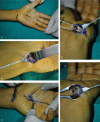The mini-incision technique for carpal tunnel release using nasal instruments in Chinese patients
- PMID: 28767593
- PMCID: PMC5626147
- DOI: 10.1097/MD.0000000000007677
The mini-incision technique for carpal tunnel release using nasal instruments in Chinese patients
Abstract
Treatment of carpal tunnel syndrome (CTS) remains a challenge for hand surgeons. Carpal tunnel release (CTR) using nasal instruments has the advantages of both endoscopy and open surgery. In this study we aimed to explore the effectiveness of CTR using nasal instruments in Chinese patients.We present a case series of 49 cases of idiopathic CTS treated with the mini-incision technique using nasal instruments. The average recovery days before return to normal work and complications were recorded. The mean grip strength, pinch strength, and sensation were evaluated. Subjective results were evaluated using the visual analogue scale (VAS), Levine Carpal Tunnel Syndrome Questionnaire (LCTSQ), Disabilities of the Arm, Shoulder, and Hand (DASH), and Medical Outcomes Study (MOS) 36-item short-form health survey (SF-36).The mean follow-up was 13 months. No return of symptoms or blood vessel injury occurred. The incidence of scar tenderness was only 8.1%, later pillar pain (after 4 weeks) was 18.4%, and average recovery time to return to normal work was 23.7 days. The mean grip strength, pinch strength, and sensation were significantly improved (P < .001). The VAS, LCTSQ, and DASH survey postoperative mean scores were lower than the preoperative scores (P < .001). SF-36 scores were significantly increased following surgery (P < .001).We conclude that the mini-incision technique for CTR using nasal instruments in Chinese patients is safe, effective, and low cost. It is worthwhile for the technique to be promoted and used.
Conflict of interest statement
The authors report no conflicts of interest.
Figures


Similar articles
-
Carpal tunnel release with a new mini-incision approach versus a conventional approach, a retrospective cohort study.Int J Surg. 2018 Apr;52:105-109. doi: 10.1016/j.ijsu.2018.02.033. Epub 2018 Feb 20. Int J Surg. 2018. PMID: 29471152
-
Minimally invasive carpal tunnel decompression using the KnifeLight.Neurosurgery. 2007 Feb;60(2 Suppl 1):ONS162-8; discussion ONS168-9. doi: 10.1227/01.NEU.0000249249.33052.7E. Neurosurgery. 2007. PMID: 17297379
-
Endoscopic carpal tunnel release is preferred over mini-open despite similar outcome: a randomized trial.Clin Orthop Relat Res. 2013 May;471(5):1548-54. doi: 10.1007/s11999-012-2666-z. Epub 2012 Oct 26. Clin Orthop Relat Res. 2013. PMID: 23100191 Free PMC article. Clinical Trial.
-
Open versus endoscopic carpal tunnel release: a systematic review and meta-analysis of randomized controlled trials.BMC Musculoskelet Disord. 2020 Apr 27;21(1):272. doi: 10.1186/s12891-020-03306-1. BMC Musculoskelet Disord. 2020. PMID: 32340621 Free PMC article.
-
Results of open carpal tunnel release: a comprehensive, retrospective study of 188 hands.Aust N Z J Surg. 1997 May;67(5):283-8. doi: 10.1111/j.1445-2197.1997.tb01964.x. Aust N Z J Surg. 1997. PMID: 9152160 Review.
Cited by
-
Comparison of carpal tunnel release with double mini-incision approach and traditional approach: A retrospective study.Medicine (Baltimore). 2025 May 16;104(20):e42510. doi: 10.1097/MD.0000000000042510. Medicine (Baltimore). 2025. PMID: 40388748 Free PMC article.
-
Two-port Endoscopic Surgery for Carpal Tunnel Syndrome - A Prospective Cohort Study.Malays Orthop J. 2022 Jul;16(2):55-62. doi: 10.5704/MOJ.2207.007. Malays Orthop J. 2022. PMID: 35992988 Free PMC article.
-
Sonographic follow-up after endoscopic carpal tunnel release for severe carpal tunnel syndrome: a one-year neuroanatomical prospective observational study.BMC Musculoskelet Disord. 2019 Apr 9;20(1):157. doi: 10.1186/s12891-019-2548-6. BMC Musculoskelet Disord. 2019. PMID: 30967143 Free PMC article.
-
Presentation and outcome of carpal tunnel syndrome with mini incision open carpal tunnel release.Med J Islam Repub Iran. 2021 May 26;35:67. doi: 10.47176/mjiri.35.67. eCollection 2021. Med J Islam Repub Iran. 2021. PMID: 34277504 Free PMC article.
-
The Influence of Wound Closure Techniques after Surgical Decompression in Patients with Carpal Tunnel Syndrome on Sleep Disturbance and Life Quality: A Prospective Comparison of Surgical Techniques.Clin Pract. 2024 Mar 26;14(2):546-555. doi: 10.3390/clinpract14020042. Clin Pract. 2024. PMID: 38666800 Free PMC article.
References
-
- Wipperman J, Goerl K. Carpal tunnel syndrome: diagnosis and management. Am Fam Physician 2016;94:993–9. - PubMed
-
- Boya H, Ozcan O, Oztekin H. Long-term complications of open carpal tunnel release. Muscle Nerve 2008;38:1443–6. - PubMed
-
- Benson LS, Bare AA, Nagle DJ, et al. Complications of endoscopic and open carpal tunnel release. Arthroscopy 2006;22:919–24. - PubMed
-
- Concannon MJ, Brownfield ML, Puckett CL. The incidence of recurrence after endoscopic carpal tunnel release. Plast Reconstr Surg 2000;105:1662–5. - PubMed
MeSH terms
LinkOut - more resources
Full Text Sources
Other Literature Sources
Medical
Research Materials

